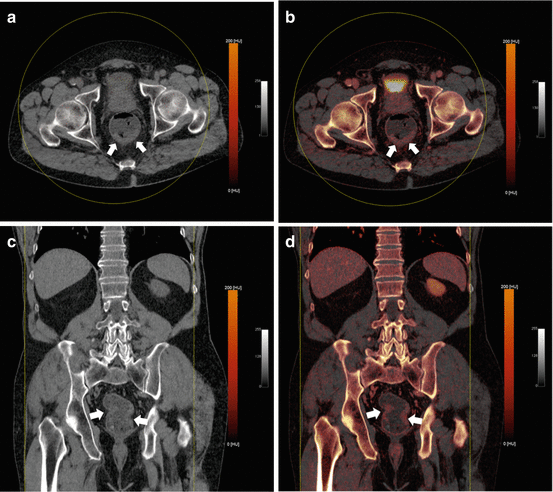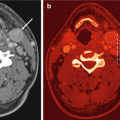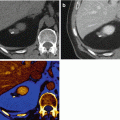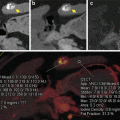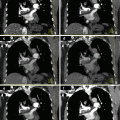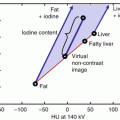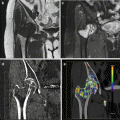Fig. 7.1
A 69-year-old male with biopsy-proven adenocarcinoma of the stomach shown on axial non-contrast-enhanced CT images (a) and fused color-coded iodine maps (b) (arrows). The DECT shows excellent intralesional iodine uptake within tumor in color-coded fashion, which makes a reliable quantification of enhancement. The region of interest displays higher contrast enhancement and iodine density within the tumor (126.9 HU; 5.7 mg/ml) compared to normal gastric wall (84.5 HU; 3.3 mg/ml), respectively (b)
Gastrointestinal stromal tumors (GIST) represent an extremely rare neoplasm which is increasingly recognized as a distinct tumor entity of soft tissue tumors. The majority of these gastrointestinal tumors are located in the stomach and small intestine and compose 1–3 % of malignant gastrointestinal tumors [16, 17]. Metastases are most common in the liver, mesentery, and peritoneum. On imaging, small GISTs are mostly well-defined solid mass with homogenous enhancement; larger tumors may show areas of hemorrhage, cystic/necrotic areas, and heterogeneous enhancement (Fig. 7.2). After contrast administration neovascularity may be seen within the tumor [18]. Therapeutic options for GIST include radical surgery for primary tumors and targeted therapy with tyrosine kinase inhibitors imatinib or sunitinib for metastatic disease [19–21]. Radiologic appearances can change drastically after therapy and knowledge of such imaging features is beneficial in managing these patients. With the recent introduction of targeted therapy for imatinib, clinical management and prognosis of GIST patients have improved significantly. Response to imatinib is characterized by decreased enhancement, resolution of the enhancing tumor nodules, and a decrease in tumor neovascularity, and these changes are usually seen within 1 month of initiation of chemotherapy [18]. Since the introduction of these molecularly targeted drugs, there has been increasing concern about the use of traditional tumor response criteria (e.g., WHO or RECIST), as several studies have indicated that response to treatment is not equivalent to a change in tumor size [22, 23]. Choi et al. have proposed the measurement of CT attenuation values as a potential indicator of GIST response in patients undergoing targeted therapy. According to the Choi criteria, tumor density is determined by drawing regions of interest (ROI) circumscribing the margin of the tumor on portal venous-phase CT images [19, 24, 25]. Choi et al. have demonstrated that a decrease in tumor size of >10 % or a decrease in tumor density of >15 % had a sensitivity of 97 % and a specificity of 100 % in detecting patients with good response to treatment with imatinib evaluated by PET-CT in metastatic GIST [18, 26]. Decreased density of responding GIST on CT pathologically correlates with the development of tumor necrosis on histopathology and cystic or myxoid degeneration; however, GIST response may result in increased density because of intratumoral hemorrhage, which is a rare but well-known effect observed during imatinib therapy [19, 27, 28] (Fig. 7.2).
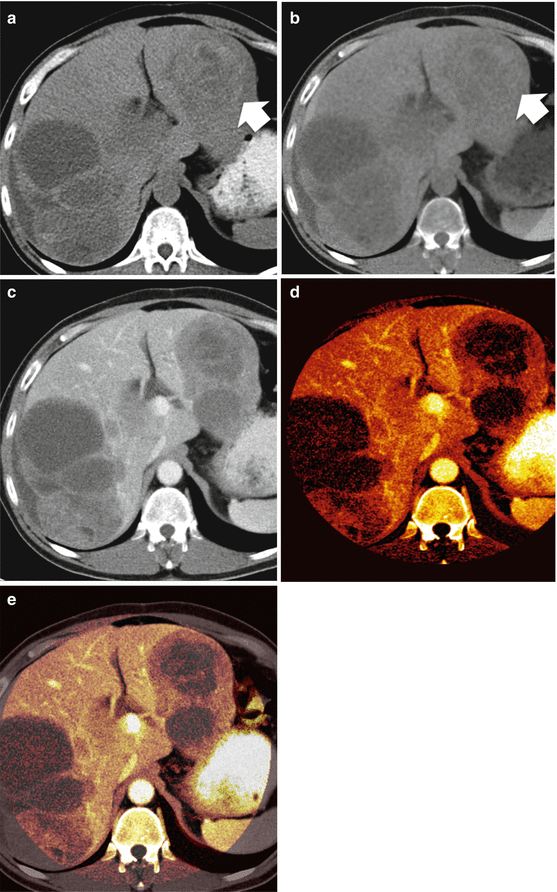

Fig. 7.2
True nonenhanced images (TNE) single-energy CT (a) and DECT (b–e) of a patient with metastatic GIST. TNE (a) and virtual nonenhanced images (b) similarly demonstrate intrametastatic hemorrhage of the liver metastasis in the left liver lobe (arrowheads). Virtual 120 kV image (c) is unable to differentiate between the intrametastatic hemorrhage and enhancing parts of the metastasis. Iodine map (e) as well as the fused iodine map (d) demonstrates the enhancing and well-perfused parts of the metastasis
DECT allows selective quantification and visualization of iodine-related attenuation (IRA) differences [19] which facilitates the generation of VNE CT images and can be used to improve the lesion conspicuity [29]. As previously described, VNE CT data calculated from DECT might potentially eliminate the need for acquisition of a separate unenhanced dataset, which could result in a considerable decrease in radiation exposure to patients [19] (Fig. 7.2). Several studies on abdominal (renal and liver) DECT have shown good correlation between VNE and TNE CT Series [30–32].
It could be recently demonstrated that DECT is a promising imaging modality for the assessment of treatment response in GIST, as IRA may be a more robust response parameter than Choi criteria [19]. DECT is capable of visualizing and quantifying typical patterns of GIST lesions. Further, DECT analysis is a promising predictor of tumor progression if compared to established response criteria. A recent analysis by Meyer et al. [23] also indicated that DECT allows a better prediction of therapeutic benefit in advanced GIST patients treated with tyrosine kinase inhibitors than established response criteria. However, the most important predictive biomarker of therapeutic benefit in this study was absence of progression, no matter which response evaluation criteria were applied.
7.3 Duodenal Carcinoma and Other Tumors of the Small Intestine
Small bowel neoplasms, such as adenocarcinoma, carcinoid tumor, lymphoma, or gastrointestinal stromal tumors, represent a small percentage of gastrointestinal cancers, however do have poor prognosis compared with other gastrointestinal malignancies [33].
Adenocarcinoma is the most common primary malignancy of the small bowel and accounts for 40 % of cancers with predominant location in the duodenum and proximal jejunum, with the incidence decreasing distally [33, 34]. In general, adenocarcinomas are more frequently found in the jejunum rather than in the ileum, except in patients with Crohn disease who are at higher risk for this specific tumor [35–37].
Carcinoid is the second most common malignancy, accounting for approximately 20–25 % of all small bowel lesions. Carcinoid tumors are more common in the ileum than in the jejunum or duodenum, and lesions may be multiple and/or metastatic at the time of diagnosis [33].
The third and fourth most common neoplasms are non-Hodgkin lymphoma (NHL) and GIST, respectively. NHL is more common in patients with celiac disease and in patients with acquired immune deficiency syndrome (AIDS), and particularly prevalent in developing countries [33].
Malignant neoplasms of the mesenteric small bowel are rare conditions, which are often discovered at an evolved stage, resulting in a poor prognosis. Consequently, early detection of small bowel neoplasms is desirable but still challenging unless appropriate imaging methods and protocols are used [35]. CT and MRI imaging have a well-known potential for providing comprehensive information, including intraluminal, mural, and extraintestinal evaluation. The association of CT scanning with luminal distension of the small bowel and intravenous administration of iodinated contrast material is the basic concept behind two specific techniques, namely, CT enteroclysis and CT enterography [35, 38, 39]. Briefly, CT enteroclysis, which is based on direct infusion of enteral contrast agent into the mesenteric small bowel through a naso-jejunal tube, provides optimal luminal distension. By contrast, computed tomography enterography is based on oral administration of enteral contrast agent [35]. MR enteroclysis is an emerging technique for the evaluation of the mesenteric small bowel, which provides excellent image quality and sufficient distention of the entire mesenteric small bowel.
On standard CT images acquired at 120 kVp, it might be difficult to discriminate between physiological and abnormal enhancement of the small bowel wall. However, as low kVp images display greater density of contrast agent than standard images, DECT might help to determine the presence of subtle inflammation when data are viewed at 80 kVp [1]. Similarly, in patients with suspected small bowel ischemia, the low 80 kVp images may aid in visual assessment of small bowel enhancement and hence perfusion [1].
Malignant neoplasms of the mesenteric small bowel are rare conditions, which are often discovered at an evolved stage, resulting in a poor prognosis. DECT might help in the task of early detection of small bowel neoplasms; however, this needs to be further evaluated by outcome-based, unbiased, and well-designed prospective studies.
7.4 Colorectal Cancer
Colorectal cancer remains a major cause of morbidity and mortality worldwide, with approximately 609,000 deaths per annum [40]. Survival of patients with colorectal cancer depends primarily on disease stage. The 5-year relative survival rate is 90 % for localized cancers but only 12 –19 % for cancers with distant metastases [41, 42]. Traditionally, colorectal cancers have been classified by clinicopathological features, including tumor location, TNM stage, differentiation, and grade. However, this may not provide sufficient information with respect to tumor profiling toward a more targeted treatment approach. Colorectal cancers are heterogeneous with respect to genetic and epigenetic mutations and may be classified by molecular characteristics [40, 43, 44].
Imaging plays an important role in the assessment of colorectal cancer, including diagnosis, staging, selection of treatment, assessment of treatment response, surveillance, and investigation of suspected disease relapse [40]. Concurrent with advances in the treatment of colorectal cancers, there have been major advances in imaging, with the development of new imaging modalities, functional imaging techniques, and contrast media and the proposal of alternative tumor response criteria [42, 45, 46]. Utilization of different imaging modalities in diagnosing of colorectal cancer varies between countries and institutions. Recent developments in imaging technologies and validation of newer imaging techniques may lead to significant improvements in the management of patients with colorectal cancers. Diagnostic techniques such as diffusion-weighted imaging (DWI), fluorodeoxyglucose positron emission tomography (FDG-PET), and dynamic contrast-enhanced magnetic resonance imaging (DCE-MRI) are increasingly used and have shown to be clinically useful in tumor characterization [47–50]. Newly developed techniques such as perfusion CT and MRI spectroscopy allowing insights in tumor biology have shown promising results; however, they are not yet validated for clinical practice [7, 8]. Recently, DECT has been investigated for direct visualization of iodine uptake within tumor in color-coded fashion, which makes a reliable quantification of enhancement [51] (Fig. 7.3). Using redcolor-encoding iodine overlay images generated by DECT, Chen et al. were able to demonstrate the extra colonic spread of the tumor [51]. The fact that cancers show enhancement of approximately 40 HU on single-energy CT during the portal phase strengthens the idea that enhancement of colorectal cancers may be used for their detection, especially when conspicuity can be increased [52–54]. In a feasibility study, Boellaard et al. could show that colorectal cancers are visible on the contrast-enhanced DECT without bowel preparation or insufflation [52]. Because of the patient-friendly nature of this approach, further studies should explore its use for colorectal cancer detection in frail and elderly patients. As technological improvements in CT continue to evolve, this will further extend clinical applications.
